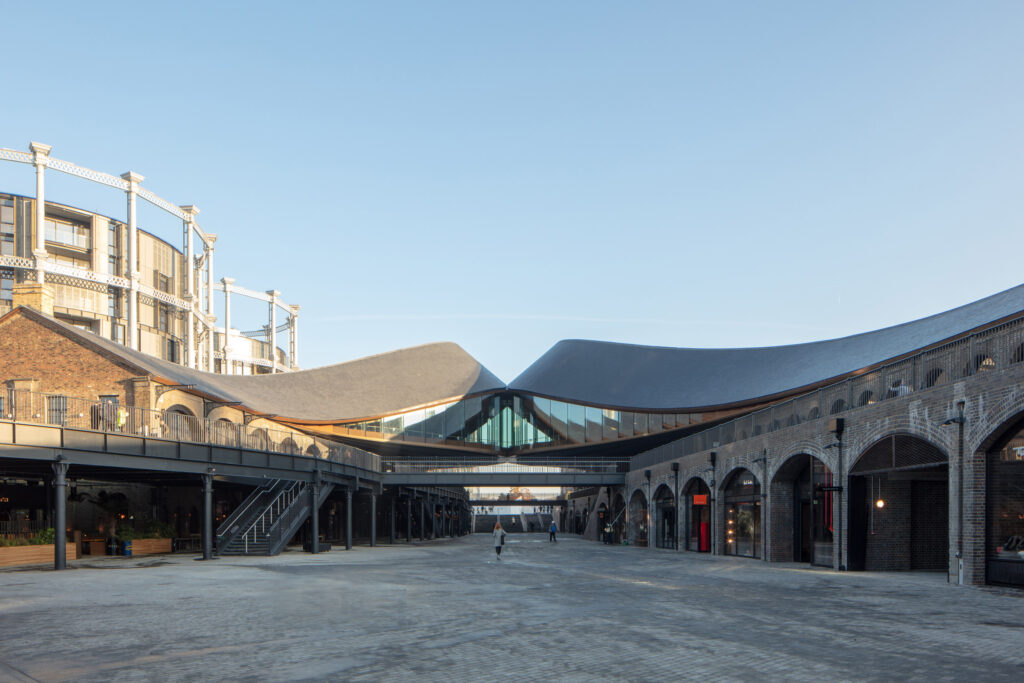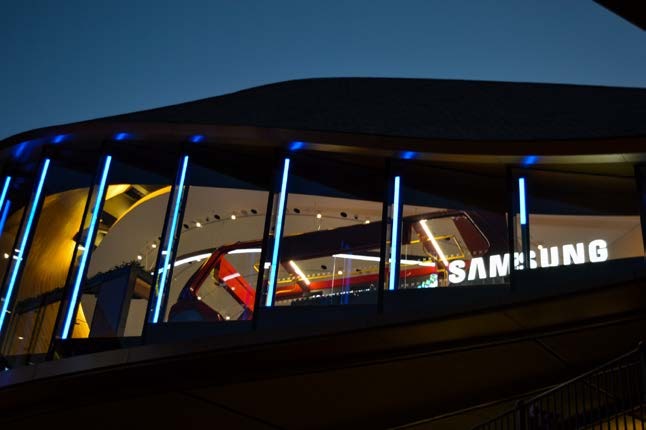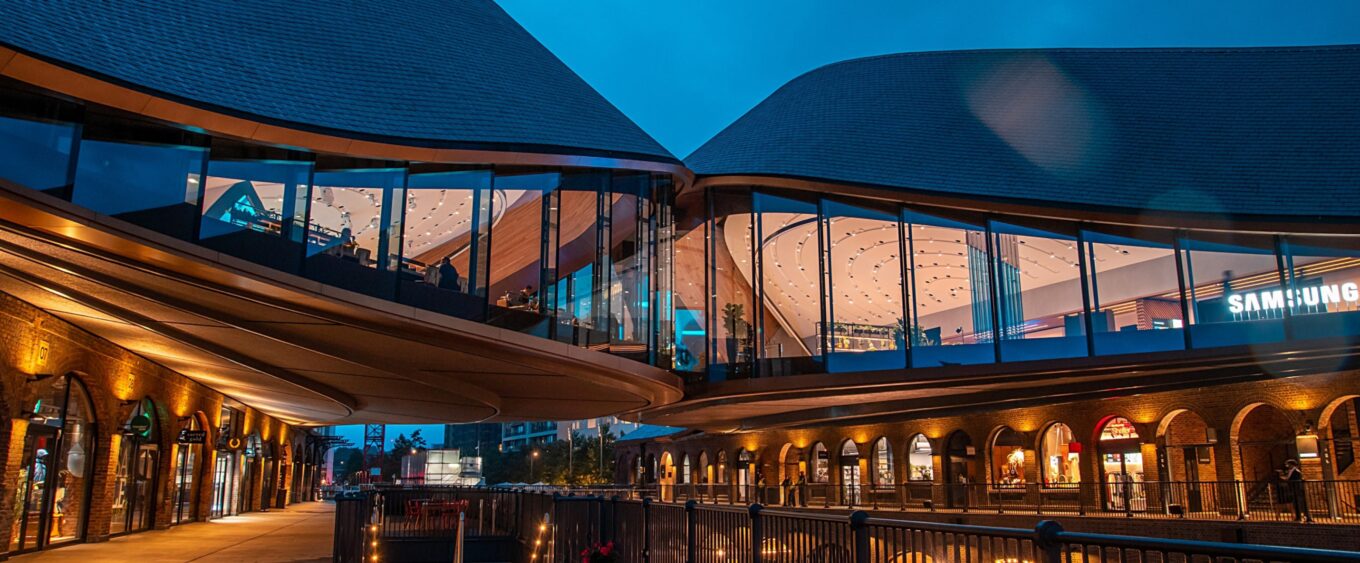MAHIKA GAUTAM recollects a walk through Coal Drops Yard, contemplating its inaccessibility and how the space reflects wider problems faced by our society.
It is 4 pm on a Tuesday afternoon, and I have decided to save £2 of my student loan by ditching the tube and walking to Coal Drops Yard. I want to explore how successfully Thomas Heatherwick’s renovated public space retains the legacy of its past, and discover what messages it embodies. Upon arrival, my phone reminds me of the latest lockdown restrictions being put in place and with this, I turn up my music – Kendrick Lamar’s album DAMN, for those curious – and look around.

I see a sequence of glass doors that curve from left to right, all similarly lit, with golden undertones and spherical, glass lampshades hanging from the ceilings. Following the curve, the famous ‘kissing’ roof appears above me. The structure is a clever manipulation of our perception of weight: the two dense slate roofs of the sheds rise from the supporting brickwork, as if made of lava, and meet midway, suspended in air. I take a moment to appreciate the fact that the slates used to create this were from the same quarry as the original roof slates, built 150 years ago. To see how reconstructions of the same material can completely redefine this area is powerful. There are steps leading to four interconnected bridges in a square around me, and from these a part of the London skyline is visible. The place certainly holds allure, and with growing intrigue, I investigate further.
The shops are sparse with visitors, but their lights shine, begging for my attention. When I grant it, I am disappointed when all I find are shopkeepers ushering me out due to maximum capacity, bars of chocolate protected under heavy glass cloches and jackets for £329 at a shop ironically called ‘Universal Works’. As I search for reminders of the historical context of the space, my underwhelmed feeling lingers. I can see iron columns have been left standing outside the shop fronts and some old brackets were left on the walls outside. Inside some shops, parts of the original Victorian rust brick walls are left exposed – but mostly they are plastered over, or hidden behind clay pots and clothes. These all hint at passers-by to acknowledge the area’s past, but with no plaques explaining their significance, I suspect these details go unnoticed by many. I stand here now, chuckling to myself at the difference between the only old notice sign left and a new sign outside a bar: one, a warning about the fragility of the roof covering, and the other, the latest food and drink promotion.


Coal Drops Yard has always been an important part of London’s identity. In the 1850s, it handled the delivery of eight million tonnes of coal annually; in the 1990s, it was the home of Bagley’s – London’s biggest rave venue for two decades. By studying the reconstruction of this space, we are able to transport ourselves to our city’s past; it gives us a range of insights, from the evolution of our energy consumption, to growing government restrictions on anti-social behaviour and drug use.
What does this latest refurbishment say about our society? Entering COS, I approach the only person in the store, the woman at the till. She tells me that she ‘really loves working there’, but also that the only facility she uses in the area are the free grass steps by the canal, near Granary Square, and the bridges to look at the skyline. As an employee working there for almost two years, she has never eaten at the restaurants and does not shop there, admitting that it’s on the ‘expensive side’. As I stand here listening to her talk about how she, too, feels excluded, I wonder which people Heatherwick Studios had in mind when they envisioned their space being used for public gathering.
The shop is full of décor designed to attract middle-class Islington mums: a hand-made clay plate for £18, simple, ‘pure cotton’ clothes, and children’s books with titles like The Boy Who Bit Picasso. Through the glass walls, the structure of the roof and the water feature ahead are visible. I like how you can look outside and gauge the time you spend here. Right now, however, it is dark outside, so all I see is a reflection of myself and the clothes behind me. I walk outside to the second floor of the shop, and in front of me is the soaring roof; it has such potential for beauty. Ideally, I would have sat here for a moment, romanticising our city. Instead, I am facing a large neon ‘Samsung’ sign across the glass windows under the roof, so bright that it hurts my eyes.

I walk home wondering why I felt so uncomfortable in that space. Anna Strongman, partner at Argent (the property developer behind Coal Drops Yard) said that the choice of shops demonstrates ideals of ‘sustainable consumption, and a more careful approach to what consumers are willing to spend their money on’. The problem with London’s obsession with volume and bargains is not due to the lack of shops providing high quality and craftsmanship, but the lack of affordability that comes with these features. The latest renovation is a stark reminder of this link between sustainability and privilege. It was a reminder of exclusivity for me, as sustainable fashion is often championed by those with white privilege. I find it particularly eerie that I, an Indian woman, cannot afford most of the ‘ethically produced’ clothes sold at Coal Drops Yard, while fast fashion often depends on people of colour, people who look like me, being exploited. The promotion of Coal Drops Yard as a public space is one which should welcome the wealth of diversity in London: all the genders, races, sexualities, abilities and classes. This should not be an unattainable utopian ideal. If we cannot ensure at least some level of inclusivity, we must question the way these new spaces are being promoted, and whether we want them to define twenty-first-century London. The failure of Coal Drops Yard to act as an all-inclusive space should be a warning sign for us to look at the more prevalent issue: the scarcity of affordable, sustainable fashion and whether the demands of our capitalist society are truly beneficial to us.
The irony of all this, of course, is that I began this journey with the intention of saving my student loan and I left with the only affordable item I could find- a plain white t-shirt from COS. I myself am a victim of one of the site’s real intentions: not to socialise, but to consume.
Featured Image Source: Hilson Moran.





